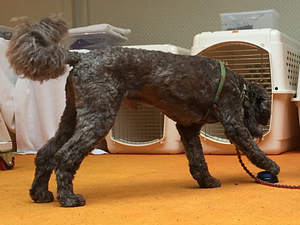
Photo by Bonner Springs Library (Flickr Creative Commons)
Many of you know that I enjoy teaching my dogs tricks, so today’s post might come as a bit of a surprise. However, there’s one behavior that dog owners love to teach that often interferes with their progress in Day School and makes their training path harder. That behavior? “Paw” or “shake.”
Teaching your dog to put his paw on you to earn praise or a treat is easy and seems like fun. But if your dog jumps up on people or paws at you for attention, you’re building value in your dog’s mind for the same behavior you’re trying to get rid of in other circumstances. It’s confusing to your dog. Is it acceptable to put your paws on people or not?
Additionally, the way most owners teach this behavior is problematic. In most cases, the owner puts a treat in their closed fist and waits for their dog to start pawing at it. When the dog makes contact with their hand, they release the cookie. We don’t want dogs to make contact with us if we’re holding food. Watch my Self-Control Around Food video and you will see why teaching “paw” in this manner is counter-productive.
We typically run into trouble while teaching down to a dog who knows paw, too. We teach down using a food lure, which turns into a hand signal. That looks a lot like the closed fist many owners use to teach “paw.”
Is it ever okay to teach “paw?”
To be clear, I’m not suggesting that you never teach your dog this behavior. I have! While earning my certification through Karen Pryor Academy, I taught it to Strata on the cue of “pound it.” It’s super cute!
But at that point, Strata had already learned over twenty different behaviors. He had extremely solid self-control around food, and he never jumped up on people.
So before you teach “paw” or “shake,” make sure that you’re satisfied with your dog’s progress with these skills:
-Your dog no longer jumps up on people.
-You have already taught “down.”
-Your dog’s self-control around food is solid.
-Your dog does not paw at people for attention or to seek petting.
 When you are ready to teach it, I recommend using a combination of shaping and targeting rather than luring to decrease confusion. Specifically, I like to shape the dog to touch an object with her paw first, and then transfer it to my hand later. This is what I did with my dog, Strata.
When you are ready to teach it, I recommend using a combination of shaping and targeting rather than luring to decrease confusion. Specifically, I like to shape the dog to touch an object with her paw first, and then transfer it to my hand later. This is what I did with my dog, Strata.
In the picture to the right, Charlie is learning to push a button with his paw. Later on, his owner could hold that button to transfer the behavior from the button to her outstretched hand or fist. Here’s a video showing how to clicker train your dog to touch a target with her paw.
Then, make sure to take the time to get it on stimulus control. That’s a fancy term that means your dog will only offer “paw” when you ask for it, and never offer “paw” in response to another cue. Eileen Anderson wrote a great blog post explaining how to achieve stimulus control, so rather than reinvent the wheel, I encourage you to check that out!
If that sounds challenging, you could consider teaching “wave” instead. With this alternative behavior, your dog isn’t rewarded for making contact with your body! That makes it an ideal skill for dogs who are still struggling with making inappropriate contact with people.
